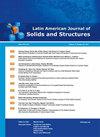Influence of stress triaxiality on the fracture behaviour of Ti6Al4V alloy manufactured by electron beam melting
IF 1.1
4区 工程技术
Q3 ENGINEERING, CIVIL
引用次数: 0
Abstract
This paper aims to investigate the influence of stress triaxiality on the fracture behaviour of Ti6Al4V fabricated by Electron Beam Melting (EBM). Here, specimens with seven configurations were manufactured and tested to obtain a wide range of stress triaxialities. A combined approach using Digital Image Correlation (DIC) and finite element (FE) modelling was used to evaluate the current stress triaxiality levels of the various specimens. The material fracture envelope was defined with the triaxiality in a range from -0.28 to 0.71, noting that the fracture was strongly dependent on the stress triaxiality. The characterisations were then carried out by testing an ad-hoc specimen to evaluate failure criteria at low and high stress triaxialities. It was shown that the FE model using the failure criterion based on triaxiality offers more accurate predictions of the material's failure response than that based on the effective plastic strain. The modelling approach based on anisotropic elasto-plasticity contributes to better predictions of the alloy's response. Thus, the failure models based on the stress triaxiality are highly recommended for producing accurate numerical predictions of the fracture response of Ti6Al4V-EBM.应力三轴性对电子束熔炼Ti6Al4V合金断裂行为的影响
本文章由计算机程序翻译,如有差异,请以英文原文为准。
求助全文
约1分钟内获得全文
求助全文
来源期刊
CiteScore
2.80
自引率
8.30%
发文量
37
审稿时长
>12 weeks

 求助内容:
求助内容: 应助结果提醒方式:
应助结果提醒方式:


